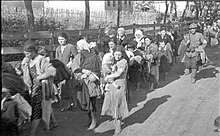Curăţirea terenului
As Curăţirea terenului ( Romanian cleaning of the land ) called General Constantin Vasiliu (1882-1946) his order from the summer of 1941 in Romania to carry out mass murders of Jews and Roma . The designation corresponded to the National Socialist propaganda expression “ Final solution to the Jewish question ”, which from June 1941 meant the Holocaust and was intended to camouflage at the same time. The Romanian “cleansing of the land” did not only involve Jews, but was part of the Holocaust.
The gendarmerie , which was subordinate to the General Staff of the Army, was commissioned to carry out this task . The army received special orders through General Şteflea, whose executor was General Ion Topor . The gendarmerie received orders to clear the country three to four days before June 21, 1941 in three different locations in Moldova : Roman , Fălticeni and Galați .
Under the rule of the military regime of Ion Antonescu , which was allied with the National Socialists, ethnic cleansing took place, which mainly affected Jews and Roma in Romania. The ideology was that "Romanianism" was endangered by the "infiltration" of foreign elements. The Jews were seen as the "greatest danger" because they were assumed to have relationships with international finance capital on the one hand and sympathies for Bolshevism on the other . The Inspector General of the Gendarmerie, General Constantin Vasiliu, explained to the NCOs and gendarmes what the cleaning of the country meant: “Extermination of all Jews in the country on the spot; Closure of the Jewish ghettos in the city area; Arrest of all suspected party activists ”. The commander of the Orheian gendarmerie region, Constantin Popoiu , specified the order: "You must exterminate the Jews from infants to helpless old men, since all of them are dangerous for the Romanian nation."
45,000 to 60,000 Jews perished in Bessarabia and Bukovina in 1941 as a result of the order to “cleanse the land”.
In the province Transnistria were over 115,000 Ukrainian Jews from the Security Police Einsatzgruppe D and Romanian soldiers killed. The local population took part because they were allowed to appropriate the property of those who were shot. Another tens of thousands of deported Jews died in makeshift camps along the Dniester of malnutrition and hunger.
In 1942, 25,000 Roma were deported to Transnistria, of whom between 11,000 and 19,000 died there. General Constantin Vasiliu was also entrusted with carrying out this operation, who described his task as "collecting and peeling the fur of stray dogs".
In 2004 the Wiesel Commission came to the conclusion that under the responsibility of the Romanian military and civil authorities 280,000 to 300,000 Jews were murdered or died. This also includes numerous Ukrainian Jews who were killed by the Romanian occupation soldiers during the war. In Transnistria, in addition to the deportees, 105,000 to 180,000 Jews living there were also killed, especially in Odessa , where 25,000 to 30,000 Jews were killed within a few days.
Constantin Vasiliu and Mihai Antonescu were executed on June 1, 1946 for the 1941 mass murders and other crimes.
See also
- Iasi pogrom (June 29, 1941: 13,000 dead)
- Romania and the Holocaust
swell
- Mariana Hausleitner: The Romanization of Bukovina: The implementation of the nation-state claim of Greater Romania 1918-1944. Munich 2001.
- Mariana Hausleitner, Viorel Achim: The Romanian Population Exchange Project Elaborated by Sabin Manuila in October 1941. In: Yearbook of the Italian-German historical institute in Trieste. Volume 27, 2001, pp. 593-617 (English).
- Andrej Angrick: Occupation Policy and Mass Murder: The Einsatzgruppe D in the southern Soviet Union 1941-1943. Hamburg 2003.
- Final report: Comisia internaţionalăpentru studierea holocaustului în România: Raport final. Iaşi 2005 (Romanian).
- Armin Heinen: Romania, the Holocaust and the logic of violence. Munich 2007.
Individual evidence
- ↑ SURSE ARHIVISTICE DESPRE HOLOCAUSTUL DIN ROMÂNIA- JEAN ANCEL , pp. 4–5. Retrieved January 17, 2020 (Romanian).
- ↑ Solonari, Vladimir. "Ethnic Cleansing or 'Crime Prevention' ?: Deportation of Romanian Roma." The Nazi Genocide of the Roma: Reassessment and Commemoration, edited by Anton Weiss-Wendt, 1st ed., Berghahn, New York, 2013, p. 109. JSTOR, online , ISBN 978-1-78238-923-1 . Retrieved January 17, 2020.
- ^ Report of the Wiesel Commission. (PDF). Retrieved January 17, 2020.
- ↑ Dennis Deletant: Living conditions in the ghettos and labor camps in Transnistria 1924–1944. The Golta case . In: Wolfgang Benz , Brigitte Mihok (ed.): Holocaust on the periphery. Jewish policy and murder of Jews in Romania and Transnistria 1940–1944. Documents-texts-materials . tape 73 . Metropol, Berlin 2009, ISBN 978-3-940938-34-3 , pp. 45-70 .

